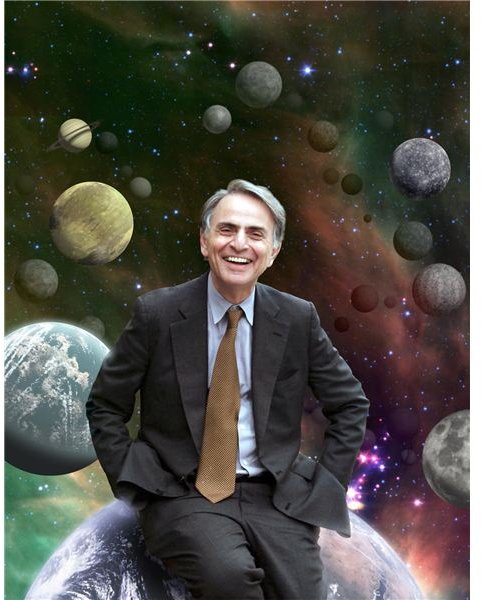Nothing But the Facts About Carl Sagan: Straight Facts, Academic Astronomy, and the SETI Program
Precious few characters in the realm of science have combined the breadth of a Renaissance man, the depth of a specialist and the charisma of a media star as Carl Sagan. Here’s an overview of his life and achievements:
The Facts
Birth: November 9th, 1934 in Brooklyn, New York
Religion: Agnostic Humanist
Ethnicity: Russian (born in US) Field: Astronomy, astrochemistry, author, exobiology Education: University of Chicago: B.A. with general and special honors (1954), B.S. (1955), M.S. (1956) and Ph.D. (1960) in astronomy and astrophysics. Key Achievements: COSMOS television show, SETI program, Contact (book, basis for movie of the same name), cofounding the Planetary Society Notable Honors: Oersted Medal, NASA Distinguished Public Service Medal (twice), Pulitzer Prize for General Fiction, National Academy of Sciences Public Welfare Meda
Death: December 20th, 1996 in Seattle, Washington
Sagan In Pictures

Sagan’s life is one of the most varied and prolific of the 20th century, and no list of facts can really do him justice. Here’s a more detailed glimpse into some of his doings:
Academic Astronomy
Almost immediately after accumulating all those degrees, he began to hold positions of honor in his beloved field of astronomy. Amongst his duties included being one of the early advisors to NASA (including multiple robotic spacecraft missions and briefing the Apollo astronauts); working at the Smithsonian Astrophysical Observatory; professorships and research at Harvard and Cornell, and—well, the list goes on for a long time.
His contributions to the field of astronomy are similarly long to list. His contributions were critical to the discovery of the incredibly high surface temperatures of Venus, which previously was thought to be an Earth-like paradise. He was one of the first to hypothesize regarding both Titan and Europa’s liquid components, both of which have been verified since then. Other studies of planet’s atmospherics resulted in the dismissal of potential vegetation on the surface of Mars, instead explaining the seasonal changes in color on the planet with duststorms. He also speculated on the existence of life on Jupiter due to the high amount of organic compounds in the atmosphere.
SETI Program, And Carl’s Own Search For Extraterrestrial Life
Carl spent much of his life fixated on the possibility of extraterrestrial life. Part of this was due to the “Drake’s Equation”, that is, an equation that attempted to mathematically quantify the factors that might lead to extraterrestrial civilizations within our galaxy. From it, many came to conclude that, for all the billions and billions of stars in our galaxy, enough of them have planets, and enough of those planets must be suitable to life, that it would be statistically more likely to win the lottery than for there not to be life in this galaxy.
Indeed, it was some of his research that resulted in proving that amino acids—necessary for life as we know it—can be derived from basic compounds by the very radiation we find in space. This and other research pioneered the field of exobiology, that is, the scientific study of life outside of Earth. He helped found SETI, the famous Search For Extraterrestrial Intelligence program, and served on the board of trustees for a number of years. On many of the space missions that he helped plan, he helped assemble messages to attempt to make contact with potential alien lifeforms on their travels, from physical plaques on space probes to radio messages from Earth into the vastness of space.
All in all, Sagan was largely responsible for opening the doors to studying the possibility of life on other planets, a thought that was popular amongst lay people but often disregarded by scientists and other academics.
King Of All Cosmos
Carl Sagan, in addition to all of the above, managed to also be a television personality to boot. His television series Cosmos focused on science and making it accessible to average people. Many a science major can attest to the strong influence of the PBS show on choosing their field! In this television show, he eloquently discussed a variety of scientific topics, from the origin of life to even just how to think critically, sharing the wonders of the universe and something of how to explore it with millions of viewers.
In addition, he also wrote numerous popular science books, including the fiction novel, Contact, which later become a movie of the same name, and a book version of Cosmos, the best selling science book ever. He appeared often in television interviews, and was often the joke of comedy skits for his characteristic pronunciation of _billions—_used to describe the number of stars in the sky, with just a little bit of spittle. He took it all good naturedly, and even had the humor to make fun of himself occasionally.
How He Tried To Save The World
From nuclear holocaust, that is. That same interest in the Drakes Equation and the the Fermi Paradox—theorizing that it is more likely that technologically advanced civilizations will destroy themselves—which led to Sagan’s intense interest in extraterrestrial life also fueled him into social advocacy back home on planet Earth.
The most famous of them arose out of the Cold War’s intense fear of nuclear bombs. He coathored the famous TTAPS report—Sagan being the _S—_which predicted nuclear winter after nuclear war, which helped bring this concept to the public forefront. This had a critical effect in changing public opinion regarding nuclear war, upping the ante in the understanding of mutually assured destruction: not only would Americans and Soviets destroy ecah other in a nuclear war, but everyone.
All in all, Carl Sagan is the sort of man that the world could use more of. The variety and depth of his research and advocacy staggers the mind, and serves as an example to everyone to step forward and try and understand the world - and the cosmos - we live in.
